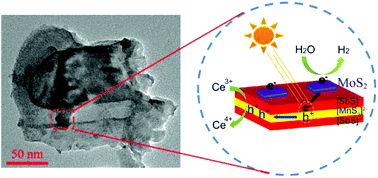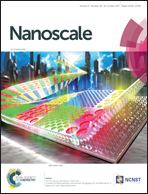In situ construction of a heterojunction over the surface of a sandwich structure semiconductor for highly efficient photocatalytic H2 evolution under visible light irradiation†
Abstract
Developing a heterostructure on the surface of a “sandwich” structure semiconductor is essential for full utilization of its heterojunction function and hence for designing efficient solar energy conversion systems. Here, we show that 2D–2D MoS2/MnSb2S4 heterostructure composites are designed for the first time and successfully synthesized by a simple in situ calcination pathway. Under visible light irradiation, the ca. 3.3 wt% MoS2/MnSb2S4 samples exhibited the highest activity for H2 evolution, which was 7.7 times higher than that of the pristine MnSb2S4 monolayer. The outstanding photocatalytic performance was attributed to the MoS2 nanosheets intimately growing on the surface [SbS]+ layers of monolayer MnSb2S4 nanosheets with the [SbS]+–[MnS2]2−–[SbS]+ sandwich substructure to form the 2D–2D MoS2/MnSb2S4 heterojunction structure. More importantly, we prove that this specific heterojunction structure can lead to more weakening of the constraint of the valence electrons in the composited photocatalysts, which can promote the transfer of photogenerated electrons from MnSb2S4 to MoS2. The present study provides a new design strategy for the construction of a heterostructure to improve the photocatalytic H2 production activity highly efficiently.



 Please wait while we load your content...
Please wait while we load your content...